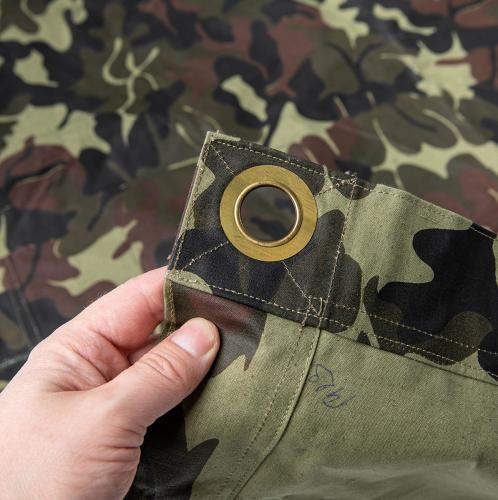


To add some confusion, the ordinary waterproofed cape with a similar name (plasch-nakidka, "cape-overcoat") was issued at the same time, but these weren't intended to combine with each other. Both pattern jackets had an external pocket on each hip and a single. Russian Army has used Plasch-palatkas (literally "cape-tents", designed to be used as both a part of a larger tent cover, or an individual weatherproof cape) since 1894, and the modern version, virtually unchanged since, was introduced in 1936, with the camo version being available since 1942. The first camouflage uniforms were the Second World War German paratrooper smock, based on their M1931 Splittermuster shelter-halves. The first printed camouflage for soldiers were the Italian Telo mimetico introduced in 1929 for their half-shelters. While the fabric is often simple olive drab, several nations use camouflaged fabric. It was a square in shape, measuring some 180x180 cm and made from a canvas water proof duck material with draw strings incorporated into one corner. The cape has been actively used as part of military equipment since the second half of the 19th. This piece of clothing/tent was introduced into the Red Army in 1936, however the idea of a cape-tent had been used in the Russian army since the days of Peter I, the first with a collar-hood cape in 1761. An important and versatile item of equipment, which offered rudimentary protection from the elements to the Red Army soldier. Plash-Palatka - Enlisted - Circa 1941-1945. Shelter-halves are usually designed to serve double duty as ponchos against the rain, or for the concealment of snipers. Cape, rope, poles, stakes and 1938 manual. I am thinking about waxing it for some added weatherproof ability. Good piece of kit, multi-use, and bombproof, albeit not lightweight. When time and space allow, some forms of half-shelters can be combined into a larger, more complex tent. I use a similar setup with the NVA zeltbahn when solo traveling and/or as a cover over the fire during rainstorms when the family is with me.

The size and shape of each half shelter piece may vary from army to army, but are typically rectangular, triangular or lozenge shaped. Often, each soldier carries one shelter-half and half the poles, etc., and they pair off to erect a two-man tent. There are better alternatives on the market, but the Soviet Plash is still the best with. Like most shelter halves used by armies worldwide, the Soviet model bends to a multitude of uses.
#Plash palatka pattern free
Shelter halves are a mainstay of most armies, and are known from the mid 19th century. Shipping starting at 12.99 USD Free 100 day returns Free shipping for orders over 200 USD.


 0 kommentar(er)
0 kommentar(er)
